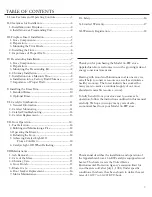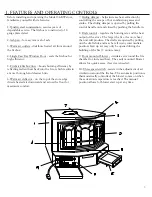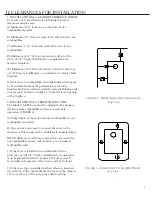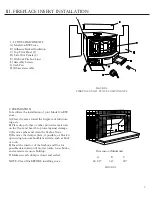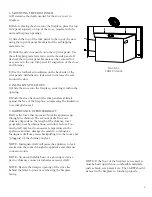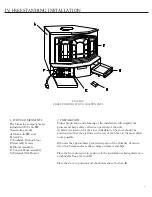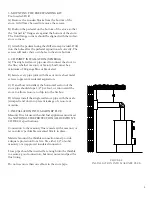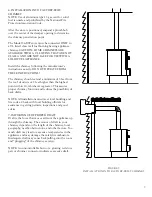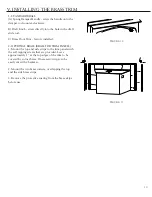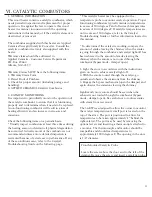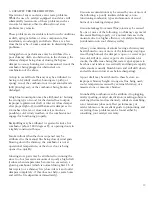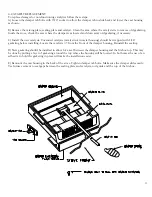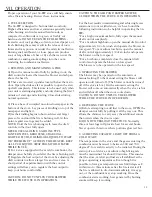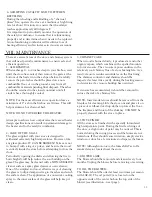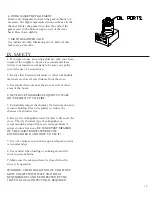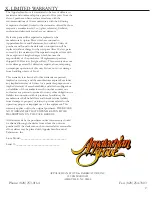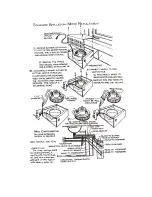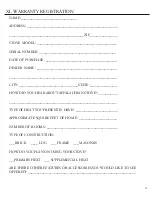
Proper operation of your 36-BW stove will help ensure
safe, efficient heating. Review these instructions.
1. FUEL SELECTION
The 36-BW is designed to burn natural wood only.
Higher efficiencies and lower emissions generally result
when burning air dried seasoned hardwoods, as
compared to softwoods or to green or freshly cut
hardwoods. DO NOT BURN THE FOLLOWING:
treated wood, coal, garbage, solvents, colored papers, or
trash. Burning these may result in the release of toxic
fumes and may poison or render the catalytic ineffective.
Burning coal, cardboard, or loose paper can produce
soot, or large flakes of char or fly ash that can coat the
combustor, causing smoke spillage into the room,
rendering the combustor ineffective.
2. BUILDING AND MAINTAINING A FIRE
A) Open the manual control fully by pulling it out; the
draft control is located between the blower and ash pan
above the hearth.
B) There are two start up slides located below the main
door. Open the slides as far as possible to open the start
up draft completely. This feature is to be used only when
your unit is starting sluggishly and only during the first 5
minutes of start up and reloading. Close slides during
normal operation.
C) Place a base of crumpled uncolored newspaper in the
bottom of the stove. Lay pieces of kindling on top of the
newspaper and light it.
D) As the kindling begins to burn, add several larger
pieces of wood until the fire is burning well. At this
point, regular size logs may be added.
NOTE: Until the fire is burning well, leave the draft
controls in the door fully open.
NEVER USE GASOLINE, GASOLINE TYPE
LANTERN FUEL, KEROSENE, CHARCOAL,
LIGHTER FLUID, OR SIMILAR LIQUIDS TO START
OR “FRESHEN UP” A FIRE IN THIS HEATER. KEEP
ALL SUCH LIQUIDS AWAY FROM THIS HEATER
WHILE IN USE.
E) For a stove equipped with a catalytic combustor, the
damper must be fully closed after the fire is burning well.
F) Regulate the heat output of the stove by adjusting the
draft controls to allow a larger fire and vice versa. A
short period of experimentation with the control
settings will allow you to regulate the heat output to
keep your home comfortable.
CAUTION: DO NOT UNPLUG YOUR BLOWER
WHILE THE STOVE IS IN OPERATION.
VII. OPERATION
CAUTION: THE ASH PAN DRAWER MUST BE
CLOSED WHEN THE STOVE IS IN OPERATION.
For the best results in maintaining and achieving fewer
emissions in your certified stove, we have found the
following instructions to be helpful in operating the 36-
BW:
*For a high or maximum burn, fully open the manual
draft control completely.
*For a medium high burn, open the manual draft control
approximately 3/4 of an inch and operate the blower on
low speed. *For a medium low burn, open the manual
draft control approximately 1/4 of an inch and operate
the blower on the low speed.
*For a low burn, completely close the manual draft
control and operate the blower on low speed.
The blower is to be operated on the low speed.
3. OPERATING THE BLOWER
The blower may be operated on the automatic or
manual setting. On the manual setting the blower will
operate until turned off. (The blower cannot be turned
off if the stove is hot.) On the automatic setting the
blower will come on automatically when the stove is hot
and will shut off when the stove cools down.
CAUTION: DO NOT UNPLUG THE BLOWER
WHILE THE STOVE IS IN OPERATION.
4. REFUELING THE STOVE
A) Before attempting to add fuel to the stove, OPEN the
damper control fully by pulling it all the way out. This
allows the chimney to carry away the additional smoke
that occurs when the door is open.
B) DO NOT OVERLOAD THE STOVE. Normally,
three or four logs will provide heat for several hours.
Never operate this stove where portions glow red hot.
5. ACHIEVING CATALYST LIGHT OFF FROM A
COLD START
The temperature in the stove and the gasses entering the
combustor must be raised to between 500 and 700
degrees F. for catalytic activity to be initiated. During the
startup of a cold stove, a medium to high firing rate
must be maintained for about 20 minutes. This ensures
that the stove, catalyst and fuel are all stabilized at the
proper operating temperatures. Even though it is
possible to have gas temperatures reach 600 degrees F.
within two to three minutes after the fire is started, if
the fire is allowed to die down immediately, it may go
out, or the combustor may stop working. Once the
combustor starts working, heat generated by burning
smoke will keep it working.
14
Summary of Contents for 36-BW
Page 18: ......


